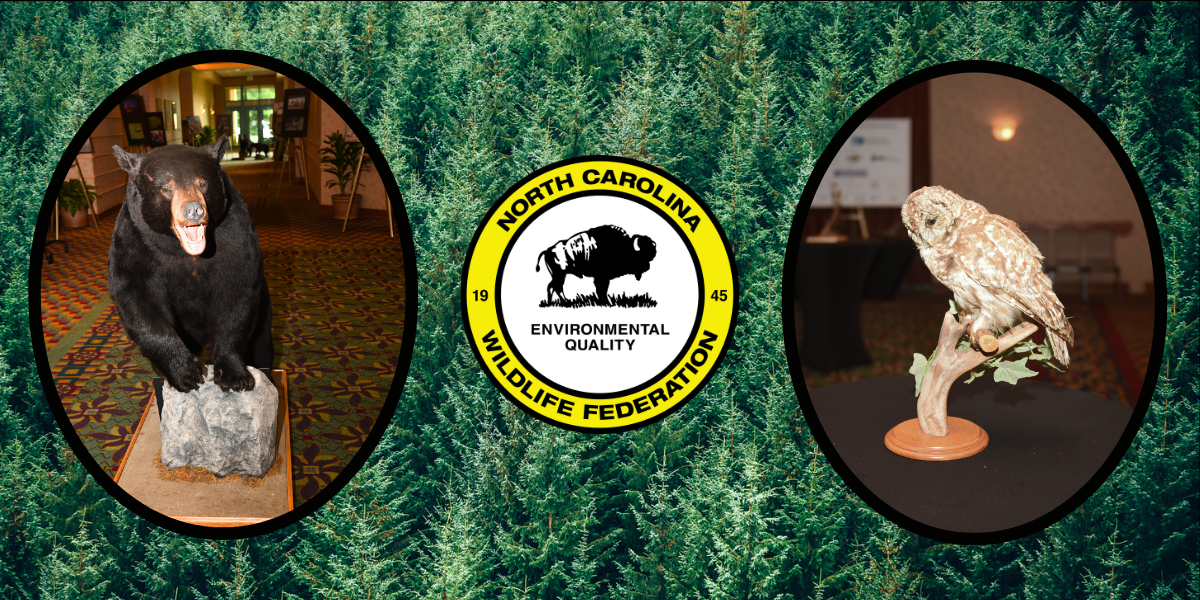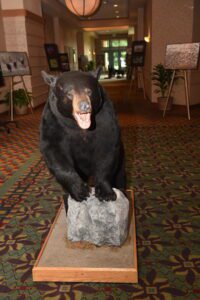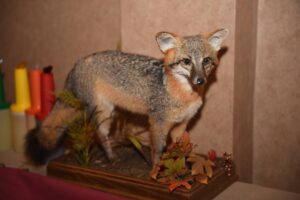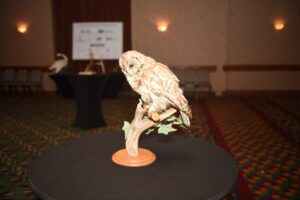Still Life – Wildlife Taxidermy and Conservation Education

In 2023, we celebrated the 59th Annual Governor’s Conservation Achievement Awards!
Here’s what you can expect to see at the Achievement Awards: hundreds of wildlife enthusiasts and conservation heroes laughing and chatting over the din of the banquet, a row of awards on the stage – set aside to be awarded to the 19 individuals and groups being recognized for their conservation achievements, photos of wildlife warriors from across the state who have dedicated years of their lives to the protection of wildlife and habitat, and – scattered about… life-sized, taxidermied animal mounts?
You read that right. Among the display items at the awards banquet are a variety of animal mounts: from a full-sized adult black bear, to an alert coyote, to a gray fox… even a red-tailed hawk!
Some may wonder: why would an organization dedicated to the protection and conservation of North Carolina wildlife display taxidermied and mounted North Carolina wildlife species? It’s a good question… one with a few answers.
But before we get there, a necessary disclaimer is required: All taxidermied mounts on display by NCWF and the North Carolina Wildlife Resources Commission at the Governor’s Awards are from actual wildlife species, but acquired primarily through donations or poaching confiscations by the North Carolina Wildlife Resources Commission. NCWF does not condone or support the unethical harvest of wildlife, or the display of wildlife that have been unethically killed or harvested.
Education
NCWF’s core values are: Protect, Conserve, Restore, and Connect. That last value, Connection, has myriad manifestations and motivations, one of which is to connect others to the outdoors and to the conservation of wildlife and habitat. Oftentimes, this is accomplished through education. Luckily, due to the multi-sensory and tactile nature of the outdoors, nature makes it easy for us. When engaging with wildlife, there are endless lessons to learn through watching, listening, and touching… sometimes even smelling and tasting!
While we certainly do not suggest – and, in fact, ask that you don’t – taste or smell the taxidermied displays at the Governor’s Awards, these mounts provide a unique educational opportunity. Mounted wildlife specimens provide an opportunity to study and analyze wildlife without entering or interfering with that species’ habitat. In this case, participants to the Governor’s Awards will have the opportunity to view a taxidermied black bear up close: the opportunity to bend down and assess the details of the animal’s anatomy. While these things are able to be observed through a mere photograph, there are things a viewer misses when looking at these species in a two-dimensional image. It’s a completely different experience to see it up close and in person, removed from the danger posed by looking at a real-life bear in its natural habitat.
Celebration
The Governor’s Awards is clearly an event to celebrate individuals who have worked to protect, conserve, and restore wildlife and habitat in North Carolina. But – ultimately – the award ceremony (and NCWF as a whole) is to celebrate wildlife, itself.
The mounts on display are a further effort to celebrate these species. A cursory glance at our website, social media profiles, and print materials communicates a clear message: NCWF is for wildlife, and we are steeped in a culture of wildlife. The hope is that the presence of these mounts further communicates that message, and helps others to feel a part of this community of wildlife.
As a part of this celebration, here’s a breakdown of some mounts you will see at the Governor’s Awards ceremony, with a little educational info on each species. While at the ceremony, feel free to snap a photo close up with the mounts… something you should never do with real and living wildlife in their natural habitat!
Black Bear (Ursus americanus):
 North Carolina’s Albemarle-Pamlico Peninsula has the highest black bear densities in the world.
North Carolina’s Albemarle-Pamlico Peninsula has the highest black bear densities in the world.
Black bears have 42 teeth, compared to humans’ 32 (28 if no wisdom teeth), which support their omnivorous diet.
Delayed implantation is a biological mechanism that allows bears to take advantage of resource availability. When food is abundant, more bears will be born. When there is a lack of abundant food sources, female bears will not reproduce every two years, but alternatively, every three to four years.
Gray Fox (Urocyon cinereoargenteus):
 Gray foxes are North Carolina’s only native fox and the smallest of the four wild canids that are present in the state, with the others being the red fox, red wolf and coyote.
Gray foxes are North Carolina’s only native fox and the smallest of the four wild canids that are present in the state, with the others being the red fox, red wolf and coyote.
Gray foxes are most often seen or heard at night due to their nocturnal habits, but are occasionally seen during the day as they search for food or other resources.
These furtive creatures mainly subsist on a diet of mice, birds and rabbits, but will also snack on seeds and wild fruit. They are very agile and will often climb trees to catch prey.
While foxes can contract rabies, fox-human interactions are very rare. To curb wildlife conflicts, it is important to avoid leaving open or unsecured pet food, compost, or garbage on your property, which often attracts opportunistic wildlife.
Barred Owl (Strix varia):
 Barred owls prefer wetland nesting sites and foraging areas and, while they can be found there, generally do not prefer mountain regions.
Barred owls prefer wetland nesting sites and foraging areas and, while they can be found there, generally do not prefer mountain regions.
There is no plumage differentiation between the two sexes of owls. However, the females are noticeably larger than their male counterparts.
They have a very diverse diet and have even been known to eat their smaller cousins, screech owls. However, barred owls are also prey, themselves, and are eaten by great horned owls and raccoons.
They are monogamous and very territorial animals, finding a nesting partner and determinedly defending their nesting sites.
Red-tailed hawk (Buteo jamaicensis):
The plumage on male and female hawks is identical, but the females are about three inches larger.
Red-tailed hawks prefer a mixture of open country and woodland terrain for hunting and nesting.
They have a diverse diet and will hunt for much of the day, sometimes soaring for hours without coming to rest.
Their top predators are great horned owls, bobcats, and humans – who illegally and/or accidentally kill this protected bird of prey.
Coyote (Canis latrans):
Coyotes have a complicated history in North Carolina – and across the United States.
They are native to North America, primarily in the western grasslands. However, with the arrival of European settlers and the fragmentation of habitat, the coyote population was pushed eastward and into North Carolina.
Coyotes are highly adaptable and are known to produce more and larger litters of pups when the population begins to decline. This creates a significant problem for species management.
Often confused with red wolves, you can tell the two apart as coyotes are generally smaller and have pointed ears and slender snouts.
Coyote-red wolf hybridization has become a significant issue in the recovery of the endangered red wolf. There are measures in place to address the problem of coyote/red wolf hybridization through the Red Wolf Recovery Program.
Red-breasted merganser (Mergus serrator):
Red-breasted mergansers are common ducks throughout North Carolina, particularly in coastal regions and often in large numbers.
Unlike the other two varieties of mergansers in the state, red-breasted mergansers prefer brackish water – though they will occasionally pay visits to small bodies of fresh water.
They flock in thousands to sounds and bays – particularly Pamlico Sound.
They primarily eat fish, and have been observed hunting cooperatively among their companions.
Bobwhite quail (Colinus virginianus):
Northern bowhite quail – or partridges – are named after their easily recognizable call: a loud, high-pitched “bob-white!”.
They are related to chickens and turkeys and – before the arrival of European settlers and their subsequent urban and agricultural development – were probably most numerous in fields and woods burned frequently by Native Americans.
The species is still common in several areas of the state, but not at their former numbers.
Bobwhite are classified as a game bird in North Carolina, though the North Carolina Wildlife Resources Commission measures the impact of hunting on the species once every three years.
River Otter (Lontra canadensis):
River otters are prominent statewide and are highly adaptable to many types of water sources.
By the late 1800s, otters disappeared from much of their range due to over-trapping. Wetland loss and water pollution worsened this decline in the 19th century. Coastal populations managed to survive due to the hunters and trappers being unable to access and infiltrate larger swamp areas. Otters vanished from western North Carolina by the late 1930s.
However, otters have since rebounded as a result of reintroduction efforts in the latter half of the 19th century.
They are nearsighted animals – most likely an adaptation to hunting in murky, low-lit underwater environments – and have long whiskers that help them navigate their surroundings. They mainly eat fish, crayfish, and amphibians and can live up to 15 years!
Striped Skunk (Mephitis mephitis)
The striped skunk is well known for its ability to spray a foul-smelling glandular secretion from its hindquarters, a formidable deterrence mechanism from predators – including humans!
There are four species of skunk in the world, and Mephitis mephitis is the North Carolinian subspecies of striped skunk. The name Mephitis mephitis is derived from the latin translation of “bad odor”.
As a member of the weasel family, striped skunks are omnivorous and have a varied diet including insects, worms, small rodents, bird eggs, reptiles, fruits, acorns and seeds.
It is best to maintain a respectful distance from skunks, both for their safety and to keep from encountering their smelly defense mechanism! Additionally, skunks are one of the largest carriers of rabies in North America. Though it is very rare to encounter a skunk with rabies, you should always exercise caution and keep your distance.

– Written by Bates Whitaker, NCWF Communications & Marketing Manager

